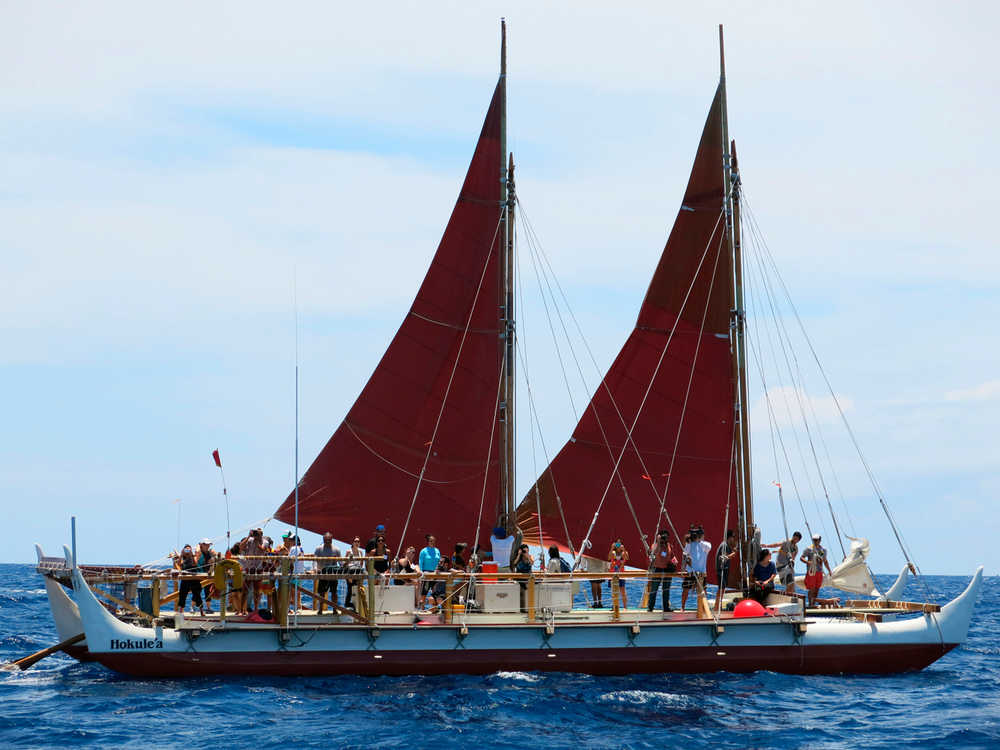HONOLULU — To take the Hokulea for a spin off the coast of Oahu is to see the Hawaiian islands in perhaps the same way as their discoverers did hundreds of years ago.
Those seafarers likely arrived on a boat resembling the double-hulled canoe, bridged by a modest deck, compelled by three sails, steered by a rudder, its components held fast with ropes rather than screws or nails.
Weather willing, the 62-foot vessel is scheduled to leave Hawaii Monday on its longest-ever ocean voyage. Relying on wind and stars to guide it, the Hokulea will chase the horizon for 47,000 miles, dropping anchor at 85 ports on six continents.
“We could be sailing around the world on a high-end yacht, but we’re not,” said Chad Kalepa Baybayan, one of five master navigators who take shifts on the Hokulea. “We’re doing it on traditionally built voyaging canoes, reflective of the architecture of voyaging canoes across the Pacific. This is a cultural project for us. It has a lot of spiritual meaning.”
The three-year tour — roughly south and west from Hawaii past Australia, around the Cape of Good Hope, to the Americas, and back via the Panama Canal — will make the Hokulea’s watershed first voyage in 1976 look like a light jog.
That roundtrip to Tahiti demonstrated, for the first time in centuries, the efficacy of ancient Polynesian way-finding and boat design. The canoe became an immediate icon amid an ongoing renaissance in Native Hawaiian language and culture.
The boat’s first navigator, Pius “Mau” Piailug, was among the last half-dozen people in the world to practice the art of traditional navigation when he agreed to teach the Hokulea’s crew.
The Hokulea endured a disastrous 1978 voyage where it capsized in a blinding storm between Hawaiian islands. Eddie Aikau, a revered surfer and lifeguard on the crew, grabbed his surfboard and paddled for help, but was never seen again.
The pilot of a passing plane spotted the wreck, saving the crew.
The crew soldiered on, and over the years, the Hokulea, which today bears a plaque with Aikau’s name, has journeyed to such distant points as New Zealand, Alaska, Easter Island, Japan and Hawaii’s remote northwest islands.
What the Hokulea once sought to tell Polynesians about themselves, it now wants to tell the world. The latest voyage — called Malama Honua, or “To Care for Our Earth” — seeks to bring the promise and raw charm of the boat itself to ports around the world.
The trip will also help train the next generation of young navigators to propagate the craft.
“You go through the oral history and you understand all the processes and concepts about it, but when you see a voyaging canoe for the very first time manifested in reality in front of your eyes? Man, that’s incredibly powerful,” said Baybayan, who first beheld the boat at 19 in 1975.
“I used to spend hours on the beach just watching her float at anchor. It was just that strong a magnet for me. And it wasn’t just for me. It was the same way for a lot of Hawaiians,” he said.
The canoe is being escorted by a modern 72-foot sister vessel called Hikianalia. A flotilla of gadgetry aboard that boat will connect the voyage to classrooms via satellite uplink, giving students throughout Hawaii and around the world a chance to see math and science in action. Crew members will perform experiments and gather data throughout the trip to fuel projects and discussions around ocean health, marine animals and sustainable living.
“What I think she can do, in a very quiet way, is bring the idea that we are all indigenous to this earth, and we all have that ocean memory,” said Jenna Ishii, one of the apprentice navigators who will take shifts during various legs of the voyage.
Those months at sea promise to be an epic adventure — if also damp, cold, itchy, salty and nauseating, Ishii said.
“I do tell kids that it seems like a beautiful, romantic thing, but most of the time it’s not,” she said. “The reality when you’re out there, when the glamour wears off, is you’re part of the ocean.”
The trip is funded through local and corporate sponsors, public agencies, foundations and other donations. Several schools and colleges have partnered with the project; Kamehameha Schools, a private school system for Native Hawaiians, has promised $2 million.
Clyde Namuo, CEO of the Polynesian Voyaging Society, which is handling the project, said he is hoping to get $30 million in cash and donated services, including crew time, to support the voyage through 2017. About half of that has already been committed, he said.

